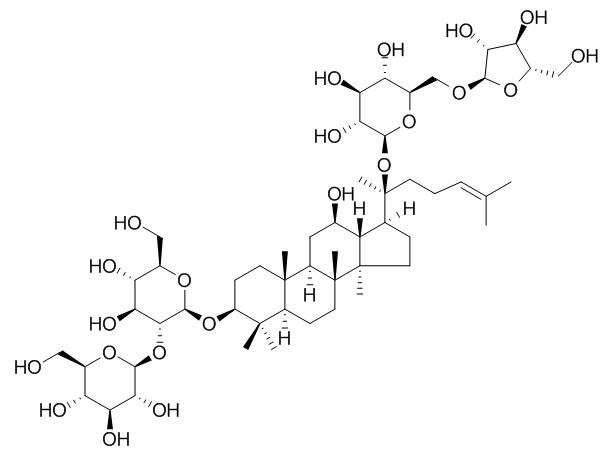Ginsenoside Rc
| Catalog No. | CFN99973 |  |
| CAS No. | 11021-14-0 | |
| Molecular Weight: | 1079.27 | |
| Molecular Formula | C53H90O22 | |
| DBs | [PubChem]:53789932 [ChEMBL]:77154 [PCIDB]:30397 |
Standard InChI:
Biological Activity
Ginsenoside Rc (Rc), a protopanaxadiol type ginsenoside, is the active component mainly responsible for the therapeutic and pharmacologic properties of ginseng, which are derived from its suppression of superoxide-induced free radicals, Rc can modulate Forkhead box O (FoxO1)phosphorylation through activation of PI3K/Akt and inhibition of AMPK and FoxO1 acetylation through interaction with CBP and SIRT1, and that this leads to upregulation of catalase under conditions of oxidative stress.[1]
Ginsenoside Rc from Korean Red Ginseng (Panax ginseng C.A. Meyer) exhibits anticancer and anti-inflammatory activities, can attenuate inflammatory symptoms of gastritis, hepatitis and arthritis.[2]
Ginsenoside Rc and Re induce c-fos in MCF-7 human breast carcinoma cells at both the mRNA and protein levels, they act via other transcription factors and not via estrogen receptor in c-Fos expression.[3]
Ginsenoside Rc significantly enhances glucose uptake by inducing ROS generation, which leads to AMPK and p38 MAPK activation.,consequently, it can be used as a potent natural anti-diabetic agent.[4]
Ginsenoside Rc can promote anti-adipogenic activity on 3T3-L1 adipocytes by down-regulating C/EBPα and PPARγ.[5]
Product
References
[1] Kim D H, Chan H P, Park D, et al. Arch Pharm Res, 2014, 37(6):813-20.
[2] Tao Y, Man H R, Lee J, et al. Am J Chinese Med, 2016:1-21.
[3] Lee Y J, Jin Y R, Lim W C, et al. Arch Pharm Res, 2003, 26(1):53-7.
[4] Lee M S, Hwang J T, Kim S H, et al. J Ethnopharmacol, 2010, 127(3):771-6.
[5] Yang J W, Kim S S. Molecules, 2015, 20(1):1293-303.
[6] Gao Y, Zang P, Hao J, et al. J Med Plants Res. 2012,6(15):3030-6.





